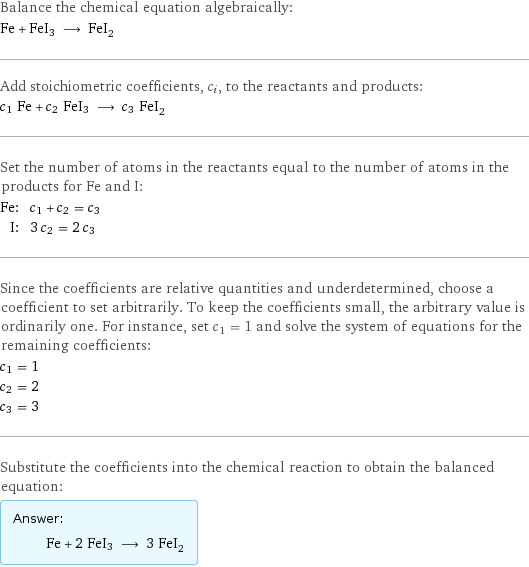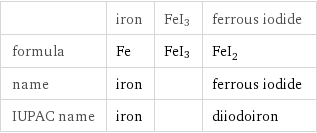Input interpretation

Fe iron + FeI3 ⟶ FeI_2 ferrous iodide
Balanced equation

Balance the chemical equation algebraically: Fe + FeI3 ⟶ FeI_2 Add stoichiometric coefficients, c_i, to the reactants and products: c_1 Fe + c_2 FeI3 ⟶ c_3 FeI_2 Set the number of atoms in the reactants equal to the number of atoms in the products for Fe and I: Fe: | c_1 + c_2 = c_3 I: | 3 c_2 = 2 c_3 Since the coefficients are relative quantities and underdetermined, choose a coefficient to set arbitrarily. To keep the coefficients small, the arbitrary value is ordinarily one. For instance, set c_1 = 1 and solve the system of equations for the remaining coefficients: c_1 = 1 c_2 = 2 c_3 = 3 Substitute the coefficients into the chemical reaction to obtain the balanced equation: Answer: | | Fe + 2 FeI3 ⟶ 3 FeI_2
Structures

+ FeI3 ⟶
Names

iron + FeI3 ⟶ ferrous iodide
Equilibrium constant
![Construct the equilibrium constant, K, expression for: Fe + FeI3 ⟶ FeI_2 Plan: • Balance the chemical equation. • Determine the stoichiometric numbers. • Assemble the activity expression for each chemical species. • Use the activity expressions to build the equilibrium constant expression. Write the balanced chemical equation: Fe + 2 FeI3 ⟶ 3 FeI_2 Assign stoichiometric numbers, ν_i, using the stoichiometric coefficients, c_i, from the balanced chemical equation in the following manner: ν_i = -c_i for reactants and ν_i = c_i for products: chemical species | c_i | ν_i Fe | 1 | -1 FeI3 | 2 | -2 FeI_2 | 3 | 3 Assemble the activity expressions accounting for the state of matter and ν_i: chemical species | c_i | ν_i | activity expression Fe | 1 | -1 | ([Fe])^(-1) FeI3 | 2 | -2 | ([FeI3])^(-2) FeI_2 | 3 | 3 | ([FeI2])^3 The equilibrium constant symbol in the concentration basis is: K_c Mulitply the activity expressions to arrive at the K_c expression: Answer: | | K_c = ([Fe])^(-1) ([FeI3])^(-2) ([FeI2])^3 = ([FeI2])^3/([Fe] ([FeI3])^2)](../image_source/4d13382966e44ccffefa2280bb617af2.png)
Construct the equilibrium constant, K, expression for: Fe + FeI3 ⟶ FeI_2 Plan: • Balance the chemical equation. • Determine the stoichiometric numbers. • Assemble the activity expression for each chemical species. • Use the activity expressions to build the equilibrium constant expression. Write the balanced chemical equation: Fe + 2 FeI3 ⟶ 3 FeI_2 Assign stoichiometric numbers, ν_i, using the stoichiometric coefficients, c_i, from the balanced chemical equation in the following manner: ν_i = -c_i for reactants and ν_i = c_i for products: chemical species | c_i | ν_i Fe | 1 | -1 FeI3 | 2 | -2 FeI_2 | 3 | 3 Assemble the activity expressions accounting for the state of matter and ν_i: chemical species | c_i | ν_i | activity expression Fe | 1 | -1 | ([Fe])^(-1) FeI3 | 2 | -2 | ([FeI3])^(-2) FeI_2 | 3 | 3 | ([FeI2])^3 The equilibrium constant symbol in the concentration basis is: K_c Mulitply the activity expressions to arrive at the K_c expression: Answer: | | K_c = ([Fe])^(-1) ([FeI3])^(-2) ([FeI2])^3 = ([FeI2])^3/([Fe] ([FeI3])^2)
Rate of reaction
![Construct the rate of reaction expression for: Fe + FeI3 ⟶ FeI_2 Plan: • Balance the chemical equation. • Determine the stoichiometric numbers. • Assemble the rate term for each chemical species. • Write the rate of reaction expression. Write the balanced chemical equation: Fe + 2 FeI3 ⟶ 3 FeI_2 Assign stoichiometric numbers, ν_i, using the stoichiometric coefficients, c_i, from the balanced chemical equation in the following manner: ν_i = -c_i for reactants and ν_i = c_i for products: chemical species | c_i | ν_i Fe | 1 | -1 FeI3 | 2 | -2 FeI_2 | 3 | 3 The rate term for each chemical species, B_i, is 1/ν_i(Δ[B_i])/(Δt) where [B_i] is the amount concentration and t is time: chemical species | c_i | ν_i | rate term Fe | 1 | -1 | -(Δ[Fe])/(Δt) FeI3 | 2 | -2 | -1/2 (Δ[FeI3])/(Δt) FeI_2 | 3 | 3 | 1/3 (Δ[FeI2])/(Δt) (for infinitesimal rate of change, replace Δ with d) Set the rate terms equal to each other to arrive at the rate expression: Answer: | | rate = -(Δ[Fe])/(Δt) = -1/2 (Δ[FeI3])/(Δt) = 1/3 (Δ[FeI2])/(Δt) (assuming constant volume and no accumulation of intermediates or side products)](../image_source/20fc0f166eb2fd5ba17a96b09bd0d000.png)
Construct the rate of reaction expression for: Fe + FeI3 ⟶ FeI_2 Plan: • Balance the chemical equation. • Determine the stoichiometric numbers. • Assemble the rate term for each chemical species. • Write the rate of reaction expression. Write the balanced chemical equation: Fe + 2 FeI3 ⟶ 3 FeI_2 Assign stoichiometric numbers, ν_i, using the stoichiometric coefficients, c_i, from the balanced chemical equation in the following manner: ν_i = -c_i for reactants and ν_i = c_i for products: chemical species | c_i | ν_i Fe | 1 | -1 FeI3 | 2 | -2 FeI_2 | 3 | 3 The rate term for each chemical species, B_i, is 1/ν_i(Δ[B_i])/(Δt) where [B_i] is the amount concentration and t is time: chemical species | c_i | ν_i | rate term Fe | 1 | -1 | -(Δ[Fe])/(Δt) FeI3 | 2 | -2 | -1/2 (Δ[FeI3])/(Δt) FeI_2 | 3 | 3 | 1/3 (Δ[FeI2])/(Δt) (for infinitesimal rate of change, replace Δ with d) Set the rate terms equal to each other to arrive at the rate expression: Answer: | | rate = -(Δ[Fe])/(Δt) = -1/2 (Δ[FeI3])/(Δt) = 1/3 (Δ[FeI2])/(Δt) (assuming constant volume and no accumulation of intermediates or side products)
Chemical names and formulas

| iron | FeI3 | ferrous iodide formula | Fe | FeI3 | FeI_2 name | iron | | ferrous iodide IUPAC name | iron | | diiodoiron
Substance properties

| iron | FeI3 | ferrous iodide molar mass | 55.845 g/mol | 436.558 g/mol | 309.654 g/mol phase | solid (at STP) | | melting point | 1535 °C | | boiling point | 2750 °C | | density | 7.874 g/cm^3 | | 5.32 g/cm^3 solubility in water | insoluble | | slightly soluble
Units
